
views
X
Research source
Further, you should never leave incense unattended, and make sure your incense is fully extinguished when you're done using it. Of course, people have been burning incense for thousands of years, all across the globe, and you can easily and safely do so in your own home as well.[2]
X
Expert Source
Karina Klimtchuk, L.Ac., DACM, Dipl. OMLicensed Acupuncturist & Diplomate of Oriental Medicine
Expert Interview. 25 August 2021.
Using a Smudge Stick, Incense Stick, or Incense Match
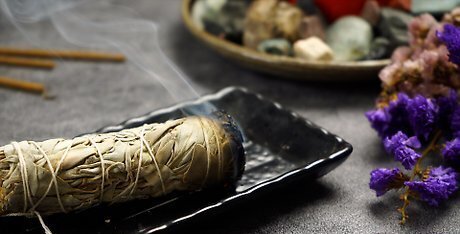
Use a smudge stick. Despite the disconcerting name, smudge sticks are perhaps the classiest type of incense. The most common type of smudge stick is made by simply tying white sage into a tight bundle. Juniper, cedar, and other botanicals can also be used. You can acquire smudge sticks – or just the herbs to make them yourself with a bit of string - from aromatherapy shops or herb stores. Smudge sticks are associated primarily with Native American cleansing practices, and may provide a feeling of more comfortable or more positive energy. Light a smudge stick at the un-tied end and allow the whole end to begin to burn. “Smudge” the stick against a dish to quell any flames and allow it to smolder. Leave the stick on its side in something that cannot light on fire, such as an ashtray or ceramic dish. Make sure there is plenty of space around the burning smudge stick.
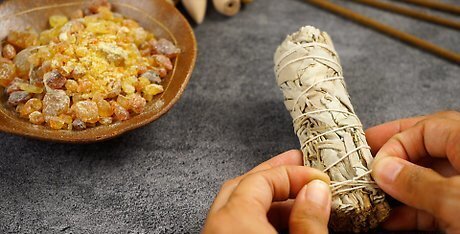
Make your own smudge stick. Tightly bundle sage branches together before they’re dried, so that the tied end is roughly equal in diameter to a nickel. Use branches that are slightly shorter than the length of your hand. You can tie the bundle in more than one location, adding a few ties a finger width apart to keep the bundle tight. Allow the bundle to dry by hanging it upside down in the sunlight. Trim the ends of the branches once the bundle has dried so that you’re left with a tight bunch of sage about the width or your palm.
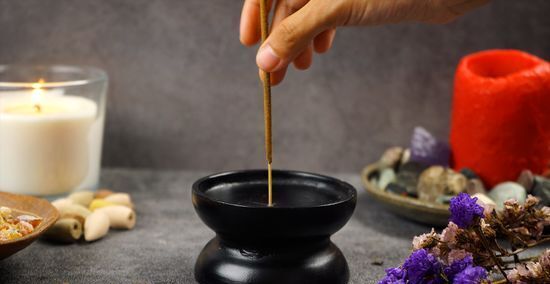
Use incense sticks and an incense burner. Incense sticks are the most widely available form of incense, and are also very easy to use. If you wish to use incense sticks, seek out a local supplier who makes their own and ensure they use high quality, non-toxic ingredients. Once you find a source that uses only safe ingredients, get an incense burner to ensure that the incense can safely burn and drop ash into a receptacle that will allow simple disposal. Stick incense burners widely vary in décor, but usually feature trays with a groove for catching ash and a curved up end with a hole, in which you place the incense stick.
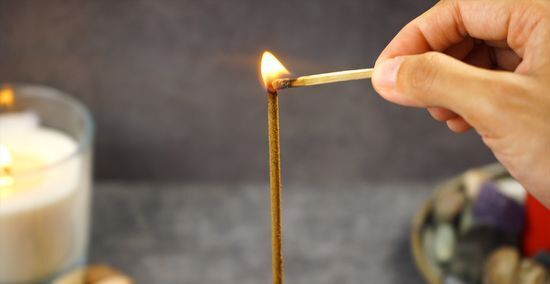
Light an incense stick with a match or lighter. Allow the stick to burn for a few moments and blow it out. A small, dull ember may remain. A steady stream of aromatic smoke should be flowing from the end of the stick. If the stream stops or is not constant, relight the stick and allow it to burn for a bit longer before blowing it out. If the ember is very bright or extends down the stick more and a few millimeters, press the burning end of the stick against the incense holder to reduce the size of the ember.
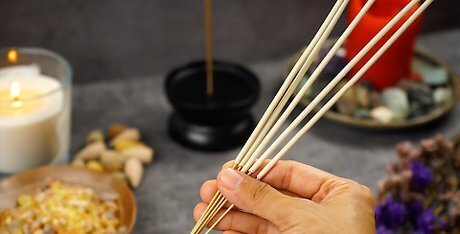
Beware of low quality incense sticks. There are many varieties of incense sticks, and two different methods of production. Dipped sticks are thin wooden sticks with a combustible coating – usually charcoal or wood pulp – that are then dipped in essential oils or synthetic fragrances and dried. Hand rolled sticks are made in a slightly different way, but the end product is very similar. Packaging for both types is not required to list all of the ingredients, which may include toxic glues or low-quality wood. Concerns about the quality of the ingredients used to make manufactured incense sticks dictate that they are likely not the safest form of incense. The lack of mandatory labeling of the ingredients in incense makes it hard to determine what incense sticks are safe to use. Since you can't assume a product is safe, only use incense stick with packaging that explicitly states that the product is non-toxic. Always shop for pure incense that is scented naturally.
Use an incense match. Incense matches are extremely easy to use. They are essentially miniature incense sticks that come on cardboard matches and are sold in matchbooks. The quality of ingredients used in incense matches, again, is often unspecified. If you do wish to use an incense match, strike the match away from you, hold it vertically, and allow it to burn about a quarter of an inch down. Blow the match out, and set it in an inflammable receptacle, such as an ashtray or small dish. Prop the match against something inflammable within the dish, as this will help the match burn more steadily. For extra ventilation, open a window before lighting your incense. You can also boost the air quality by using an air purifier.
Burning an Incense Cone
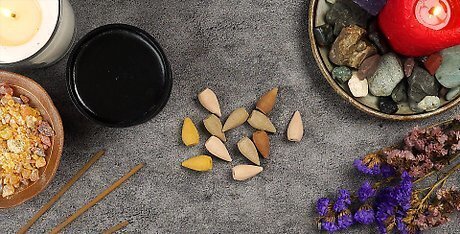
Use an incense cone. Incense cones are becoming increasingly more popular, and offer a similar, but slightly different experience to that derived from using an incense stick. Look for incense cones made using Makko powder – derived naturally from a special type of neutral-smelling and slowly burning wood – and essential oils. Cones can emit variable amounts of aroma based on the amount of fragrance used in making the cone. This will allow you to choose a level of aroma, including either very subtle or very potent, that you prefer.
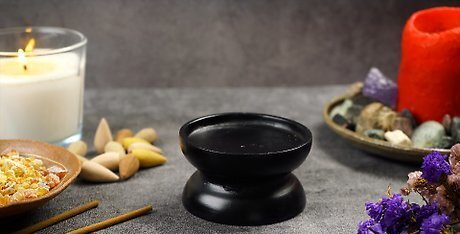
Find a safe incense holder or box. Since incense cones burn all the way down, the holder in which you place them must be inflammable, as embers will touch it directly as the cone burns to the end. Boxes and dishes of various materials are available, including elaborate works of stone and porcelain. Even wood boxes can be used, as long as brass inserts contain the actual cone and the residue and ash that is produced as the cone burns. If you use a simple ceramic dish, you may want to place a quarter or other metal disc beneath the cone, as the bottom of the cone can become extremely hot.

Add sand or rice to the bottom surface of an incense holder. Though it is not a necessary step, adding a smooth layer of sand to the bottom of your holder upon which you can place an incense cone will allow air to better access the cone. Further, this additional layer will reduce the amount of heat that the holder itself is exposed to, which may help certain material from aging or even cracking.
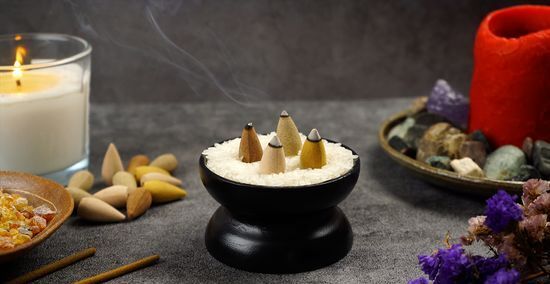
Light the tip of the inverted cone. You can use a lighter or match. Allow about a dozen seconds to pass before putting out the cone’s flame. Waiting will allow the cone to fully light and produce an ember that will continue to burn once the flame is extinguished. There should be a continual stream of smoke emanating from the tip of the cone. Allow the cone to burn as long as you wish. You can put it out and relight it later if it does not burn all the way.

Keep cones dry. The main reason that a cone may quit burning is a lack of oxygen. If you’re using an incense box and the incense keeps going out, try removing the lid. If oxygen proves not to be the issue, the cone may have still be damp from production or it may have been exposed to moisture. Dry the cone out by placing it somewhere you know the air is dry. For regular storage, keep cones in a cool, dry location out of direct sunlight.
Crafting and Lighting an Incense Trail

Indent a path for an incense trail in white chaff ash. Fill an incense bowl with white chaff ash, and tap the bowl lightly to settle the ash. Make an indentation in the ash that is one continual line. You can make a “U” shape, a spiral, or anything else that comes to mind, as long as the indentation is a single continual line. Most importantly, the indentation should be about half an inch deep and half an inch wide. You can get white chaff ash from some stores that sell incense or online. You can use a koh press to make an indentation, which are designed for this purpose, and were originally used to create elaborate incense trails that also doubled as a method for keeping time.
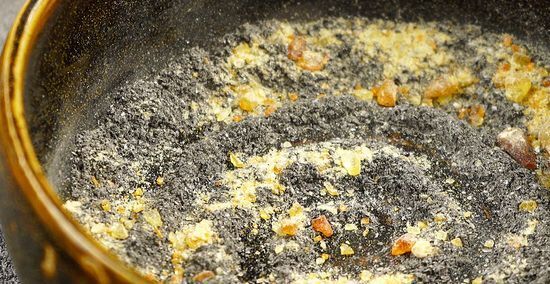
Fill the indentation with pre-mixed incense, Makko powder, or Sandalwood powder. Sandalwood powder will burn and provide an aroma of its own. Makko powder has a more neutral aroma, and you can either sprinkle loose incense on top of a burning Makko powder trail or pre-mix incense of your choice with Makko powder before filling the indentation. Slightly press the trail down once you’ve filled the indentation with the desired aromatic material.
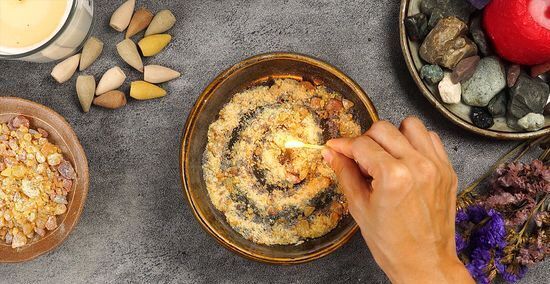
Light the trail with an incense-lighting stick or match. You can get wood stick designed to light incense, or simply use a match. Lay either at one end of the trail and leave it there to allow the trail to light. If you used plain Makko powder to fill the indentation and make your trail, sprinkle loose incense on the trail once it is bright orange or red.

Allow the trail to cool once it has fully burned. Remove the spent trail with a spoon and discard it, making sure it is fully extinguished. Any ash that has not been mixed with burnt material from the trail can be re-used.



















Comments
0 comment